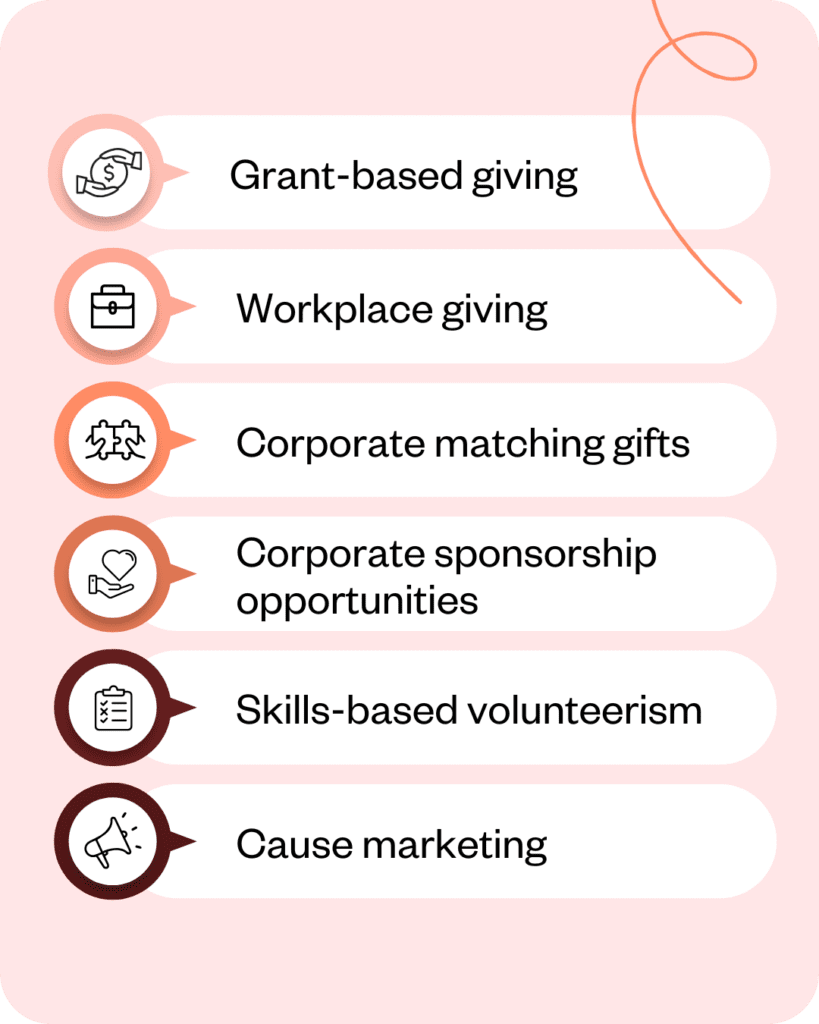
$36.55 billion. That’s how much US nonprofit corporate partnerships raised in 2023. It’s an impressive number — but the landscape is changing. Fast. Now more than ever, corporate fundraisers need to think strategically and act creatively if they want to sustain and grow their corporate giving programs.
In this article, we’ll take a closer look at the essentials of nonprofit corporate partnerships and share practical tips to help your team find and build long-term relationships.
What are nonprofit corporate partnerships?
A nonprofit corporate partnership is when charitable organizations and for-profit companies come together in pursuit of a shared goal. While some partnerships are linked to a single event or limited timeframe, others evolve into long-term initiatives that bring huge benefits to both organizations.
Understanding different types of corporate partnerships
From financial support to volunteer opportunities, partnerships with for-profit companies can unlock all kinds of creative possibilities. Here are some of the most popular:
Grant-based giving
The most traditional form of corporate philanthropy, companies donate a portion of their profits through a foundation, typically through a formal application process.
Workplace giving
Think individual giving, but in a company context. Employees make direct donations to nonprofit organizations through their paycheck, or via ‘Charity of the Year’ partnerships.
Corporate matching gifts
A great way to engage employees, companies offer matched-funding to people raising money as part of challenge events and fundraisers.
Corporate sponsorship opportunities
Is your event short on budget? Corporate sponsorships are a great way to close the gap, with companies paying to support an event or program in exchange for brand exposure.
Skills-based volunteerism
Also known as pro-bono support, employees donate their time and skills to advance a nonprofit’s mission — for example by providing legal support at no cost.
Cause marketing
A personal favorite, cause marketing is a truly creative process that sees companies donate a percentage of product profits to a nonprofit organization, often co-branding initiatives to help raise awareness and boost sales.

The benefits of building nonprofit corporate partnerships
With so many options available, it’s no wonder nonprofit organizations want to develop corporate giving programs. For many, these partnerships aren’t just a way to raise money. They are also an important opportunity to expand their reach and build their brand profile.
For companies, nonprofit corporate partnerships don’t just provide a way to give back. They are also a strategic business decision — one that can help boost employee engagement, raise visibility through corporate sponsorship, and build their reputation for corporate social responsibility.
10 steps to building great corporate nonprofit partnerships
With over six million for-profit companies (employer firms) registered in the US, launching a new corporate giving program can feel overwhelming. The following steps are designed to help you navigate this, find potential corporate partners, and build productive, long-lasting relationships.
Step #1: Understand your value
Successful partnerships are built on shared value and will offer for-profit companies a clear win-win. Before you start researching potential corporate partners, take some time to understand your nonprofit value proposition. Questions to ask include:
- Why should for-profit companies choose you?
- What unique benefits or value can you offer?
- How will you engage company employees?
- Can you offer exclusive experiences, like program visits?
While most nonprofit organizations offer impact stories and data, it’s the extras — think shared PR, corporate sponsorship and volunteer opportunities — that will set your organization apart.
It’s also important to consider how your nonprofit organization can help for-profit companies reach their business and corporate social responsibility goals. Being able to clearly articulate this added value is key to building strong, successful partnerships.
Top tip: Why not use a tiered partnership model that offers clearly defined benefits for different levels of corporate philanthropy?
Step #2: Focus your search
No business will give “just because.” Map out the industries and sectors that align with your nonprofit’s mission. For example, if you’re a health-focused nonprofit organization, you might explore partnerships with pharmaceutical or medical device companies. If you’re in education, publishers, digital learning platforms, or tech companies could be a good fit.
Top tip: Review your current donor base to see if any companies show up more than once. This could be an opportunity to start deepening your relationship.
Step #3: Identify top potential corporate partners
Once you’ve defined your target sectors, start researching individual companies. To find your top prospects, you will need to rank them against a clear criteria. For example:
- Strategic match: How closely do your mission and values align?
- Giving patterns: Who do they give to, how much and how often?
- Commitment: Have they publicly committed to delivering corporate social responsibility?
- Brand reputation: Are there any ethical concerns surrounding company practices?
- Connections: Do yo have any connections or contacts you can leverage?
Top tip: Don’t go it alone! Use prospect research tools like Kindsight’s iwave to uncover valuable insights into company giving histories and priorities.
Step #4: Connect with the right people
Once you’ve identified your potential corporate partners, you need to find a point of contact. Some companies will have a very clearly defined process, guidelines, and connection point. Others will require a little bit more background research.
It’s worth the effort. Taking the time to find and connect with the right person will increase your chance of a positive response.
Top tip: Don’t just reach out to C-suite leaders. Managers and coordinators are often more accessible and willing to engage in discussion around nonprofit corporate partnerships.
Step #5: Map your networks
You don’t need to be an influencer to have a powerful network. Even if you’re early in your career, you will be surprised how many people you know. Add your team, board, and CEO into the mix, and you’ll soon build a map of contacts who can help open doors.
Top tip: You can use LinkedIn to search for team members at your target company and check for any first or second connections. Don’t hesitate to ask for an introduction!
Step #6: Count conversations, not cash
Good partnerships take time. Unless the company has a formal application process, sending a proposal too soon can turn people off. At this stage, your goal is to start a conversation. The more you have, the more likely you’ll receive an invitation to apply.
Framing your work this way— counting conversations before cash — can help take the pressure off. It’s also a great way to track your progress and see momentum build over time.
But what to say?
Your approach will vary depending on who you’re talking to, and whether or not it’s a warm or cold lead. That said, it’s important to keep your first message short, friendly, and professional, with a clear signpost to next steps.
Here’s a simple structure you can follow:
- A catchy opening
Grab attention in a warm, relevant way. Reference something timely, shared, or specific to the person/company. - Introduce your nonprofit organization
Keep it brief! Just one or two lines on who you are, what you do, and why. - Explain why you’re reaching out
Be clear: you’re exploring potential partnership opportunities, such as X, Y, or Z. - Strategic alignment
Highlight how your missions overlap and the value your organization can bring. - Ask for a conversation
Suggest a quick meeting or call to explore alignment further — keep it low-pressure. - Close with thanks
Always end on a polite note with gratitude and a simple sign-off.
Top tip: If it feels right, why not share a few light marketing materials? A simple brochure or flyer can add credibility and context to your message without feeling overwhelming.
Step #7: Get to know your prospects
Once the conversation’s started, take every opportunity you can to get to know your donor, their needs, motivations, and priorities. You can use this information to build a truly bespoke proposal that will improve your chances of success.
Top tip: Wherever possible, involve your prospective donor in shaping your ask. The more involved they are, the more invested they’ll be in a successful outcome!
Step #8: Prepare a compelling proposal
If you’ve got to this point, you’re already winning — so take some time to recognize your progress. While there’s no single format for the proposal you submit (they should each be highly tailored), a good submission usually includes the following elements:
Executive summary
No one should have to skip to the end to see what you’re asking for. Start your proposal with a clear summary of the need, your goals, and the ask.
The challenge
Now’s your chance to tell your story. Explain the social issue you’re addressing and how your organization is making an impact. Share your expertise, headline results, and impact.
The opportunity
Now is the time to sell. Show how your work aligns with the company’s goals and how their support will benefit you — and them!
The idea
You’ve sparked their interest, so now it’s time to get specific. Share details on your proposed nonprofit corporate partnership, how it will work, and the roles of each partner.
The benefits of partnering with you
Reinforce the value your organization brings. Highlight your unique strengths and the opportunities you offer, using your list from Step 1 to showcase what sets you apart.
Case study
Include an example of a similar partnership or project that highlights the impact of your work. This builds credibility and creates an emotional connection with the reader.
Budget
Provide a clear breakdown of the financials involved, including what funds will be used for and any specific contributions required. Always be transparent and realistic about costs!
Other relevant information
Before closing, include any relevant additional details such as timelines, deliverables, or specific resources required.
A final call to action
End your proposal with a clear, compelling call to action that leaves your potential corporate prospect in no doubt as to what they should do next.
Top tip: If you have the resources, consider getting your proposal professionally designed to help the receiving company picture how your brands could look together.
Step #9: Follow up and keep heart
Once your proposal is in, be sure to follow up. Don’t lose heart if it all takes time or the result is not what you expected. Building strong corporate giving programs can take years. Take a breath, ask for feedback and keep on going. Just because you weren’t successful this time, doesn’t mean you won’t be the next.
How to maintain and strengthen corporate partnerships
Remember, the work doesn’t stop when the agreement is signed. To ensure partnership success and longevity, you need to build a relationship that maintains momentum over time — and with that, we come to our final step:
Step #10: Focus on the Journey
Every corporate partner will need a bespoke donor journey. This will include all reporting and technical elements of your agreement, as well as some added extras. Keep the momentum going by regularly checking in, sharing ad hoc updates and organizational news. If it’s appropriate, you could even offer additional corporate sponsorship opportunities, or invite organizations (and their employees) to join challenge events or a behind-the-scenes tour.
Examples of successful nonprofit corporate partnerships
Looking for some inspiration? Here are few popular nonprofit corporate partnerships to help spark some ideas and creative thinking:
- Ralph Lauren and their “Pink Pony” campaign
A great example of cause marketing that turns their iconic logo pink. 100% of the purchase price is donated to Ralph Lauren’s fight against cancer.
- Costco and the Children’s Miracle Hospital Network
Every May, customers across the US are given the chance to donate when they buy online or directly at a Costco warehouse.
- Duolingo promotes employee engagement
Social impact activities include programs that encourage employees to join nonprofit boards, corporate matching gifts, and volunteer opportunities at local nonprofits.
- CVS in support of the American Heart Association
More than a campaign, “Go Red for Women” is a movement that encourages people to wear red to mark World Heart Day, buy branded items, and donate at CVS registers.
Final thoughts
Few areas of fundraising offer more room for creativity, innovation, and impact than corporate partnerships. Just remember: sustainable programs take time. Do your research, build real relationships, and create tailored, value-driven proposals — and you’ll have all the ingredients you need for success.
Be the first to read our resources.
The world is changing quickly—and our resources help you stay on top of it all. Sign up to get new insights, success stories, and more, sent right to your inbox.




